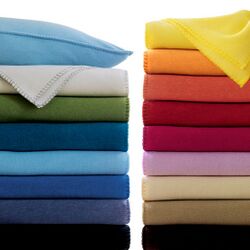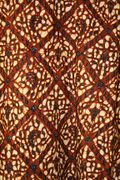Engineering:Polar fleece: Difference between revisions
(simplify) |
(No difference)
|
Latest revision as of 21:28, 3 February 2024

Polar fleece is a soft fabric made from polyester that is napped and insulating.
PolarFleece as a trademark registered by Malden Mills (now Polartec LLC) with the United States Patent and Trademark Office on October 6, 1981.[1] Malden Mills developed polar fleece in 1979.
Uses
Polar fleece is used in jackets, hats, sweaters, sweatpants, cloth diapers (nappies), gym clothes, hoodies, pajamas, blankets, and high-performance outdoor clothing. The produced fleece can be used to create clothes that are very light, soft, and easy to wash. Polar fleece can stretch more easily in one direction than in others.[2]
History
Polar fleece originated in Massachusetts in 1979 when Malden Mills and Patagonia developed Synchilla (synthetic chinchilla).[3] It was a new, light, strong pile fabric meant to mimic, and in some ways surpass, wool. Malden Mills CEO Aaron Feuerstein intentionally declined to patent polar fleece, allowing the material to be produced cheaply and widely by many vendors, leading to the material's quick and wide acceptance.[4][5][6] Malden Mills registered PolarFleece as a trademark with the United States Patent and Trademark Office on October 6, 1981.[7]
Characteristics
A lightweight, warm and soft fabric, fleece has some of wool's good qualities. Polar fleece garments are traditionally available in the micro, 100, 200, and 300 variants, where the numbers represent the fleece's weight in grams per square meter (gsm). The heavier fleece are warmer.
Fleece can range from being high loft to tightly knit. High loft fleece is warmer because it traps tiny air pockets which hold your body heat.[8] Traditionally, polar fleece always had a two-sided pile (i.e., they were fluffy on both sides), but now clothes are often advertised as polar fleece even if they lack a two-sided pile.[9][10] High pile fleece (which have a higher loft), will eventually lose some loft by becoming matted over time. High pile fleece are also more prone to collecting dirt than low pile fleece. To prevent high pile fleece from matting, they can be brushed regularly (which also removes dirt) and hung rather than folded.[11] To remove already existing matting, rinse it in cool water and vinegar, and while it is still damp, gently and unidirectionally brush the matting out (while optionally lightly spraying it with fabric softener mixed with water), and then use a lint roller.[12]
It is hydrophobic, holding less than 1% of its weight in water. It retains much of its insulating quality even when wet. It is machine washable and dries quickly. It is a good alternative to wool for those who are allergic or sensitive to wool. It can also be made out of recycled polyethylene terephthalate (PET) bottles, or even recycled fleece.
Regular polar fleece is not windproof[13][14] and does not absorb moisture (although this is often seen as a benefit, per above).[15][16][17] Fleece readily generates static electricity, which causes the accumulation of lint, dust, and pet hair. It is also susceptible to damage from high temperature washing, tumble drying, or ironing under unusual conditions. Lower-quality polyester fleece material is also prone to pilling (i.e., the jacket's fabrics break and reform into tiny balls on the jacket).
Microfiber pollution
Washing synthetic textiles like fleece releases microfibers, a type of microplastic.[18] The release of these microfibers into the wastewater is proportional to the microplastic pollution in soil, marine, and freshwater habitats.[19] Studies also show that tumble drying of polyester releases airborne microplastics.[20]
References
- ↑ Polarfleece; Registration Number 1297628; Malden Mills, Inc., 46 Stafford St. Lawrence, Massachusetts 01841; First use June 16, 1980; Filing Date October 6, 1981; Published for Opposition July 17, 1984; Registration Date September 25, 1984
- ↑ Polar Fleece history and the history of pile fabrics Bookrags.com
- ↑ Greenbaum, Hilary; Rubinstein, Dana (November 25, 2011). "The Evolution of Fleece, From Scratchy to Snuggie". The New York Times. ISSN 0362-4331. https://www.nytimes.com/2011/11/27/magazine/fleece-scratchy-to-snuggie.html.
- ↑ "Xavier hosting Aaron Feuerstein on March 30". Citizens For A Better Norwood. June 29, 2009. http://citizensforabetternorwood.blogspot.com/2009/03/xavier-hosting-aaron-feuerstein-on.html.
- ↑ Shafran, Avi (June 22, 2002). "Mr. Feuerstein is a legend in the corporate world, keeping his employees on the payroll until the plant could be rebuilt after a fire. His company went bankrupt, and was purchased out of bankruptcy, yet he doesn't regret a thing.". http://www.aish.com/ci/be/48881397.html.
- ↑ "Aaron Feuerstein". July 7, 2006. https://www.youtube.com/watch?v=9YcWLXBXaD8.
- ↑ Polarfleece; Registration Number 1297628; Malden Mills, Inc., 46 Stafford St. Lawrence, Massachusetts 01841; First use June 16, 1980; Filing Date October 6, 1981; Published for Opposition July 17, 1984; Registration Date September 25, 1984
- ↑ "Backpackers Guide to Fleece Jackets 2021: Is it Warm and Breathable?" (in en-US). https://backpackers.com/outdoor-guides/backpackers-guide-to-fleece-jackets/.
- ↑ "Understanding the Different Types of Fleece Fabrics" (in en). 2020-08-26. https://www.fabricsgalore.co.uk/blogs/news/understanding-the-different-types-of-fleece-fabric.
- ↑ Keefe, Ben (2022-01-07). "From Sherpa To Slub: The Types Of Fleece To Know". https://www.heddels.com/2022/01/from-sherpa-to-slub-the-types-of-fleece-to-know/.
- ↑ "Caring For Your Deep Pile Fleece" (in en). 2021-06-13. https://gorpgoods.com/blogs/digital-gorp/caring-for-your-deep-pile-fleece.
- ↑ Higson, Alex (2021-09-28). "How To Fix Matted Sherpa? A Step-By-Step Guide" (in en-US). https://www.magicofclothes.com/fix-matted-sherpa/.
- ↑ Polartec Windpro web page
- ↑ Polartec Windpro web page
- ↑ Columbia Layering Guide for Warmth and Comfort by Frank Ross
- ↑ Choosing and Using a Quarter Sheet. Discussion of characteristics of wool vs. fleece
- ↑ Moisture Buffering
- ↑ Pirc, U.; Vidmar, M.; Mozer, A.; Kržan, A. (2016). "Emissions of microplastic fibers from microfiber fleece during domestic washing". Environmental Science and Pollution Research International 23 (21): 22206–22211. doi:10.1007/s11356-016-7703-0. ISSN 0944-1344. PMID 27658400.
- ↑ Šaravanja, Ana; Pušić, Tanja; Dekanić, Tihana (April 2022). "Microplastics in Wastewater by Washing Polyester Fabrics". Materials 15 (7): 2683. doi:10.3390/ma15072683. PMID 35408015. Bibcode: 2022Mate...15.2683S.
- ↑ Science, Public Library of Science (April 6, 2022). "Tumble dryers release microfibers into environment at levels comparable to washers" (in en). https://phys.org/news/2022-04-dryers-microfibers-environment-washers.html.
External links
 |




